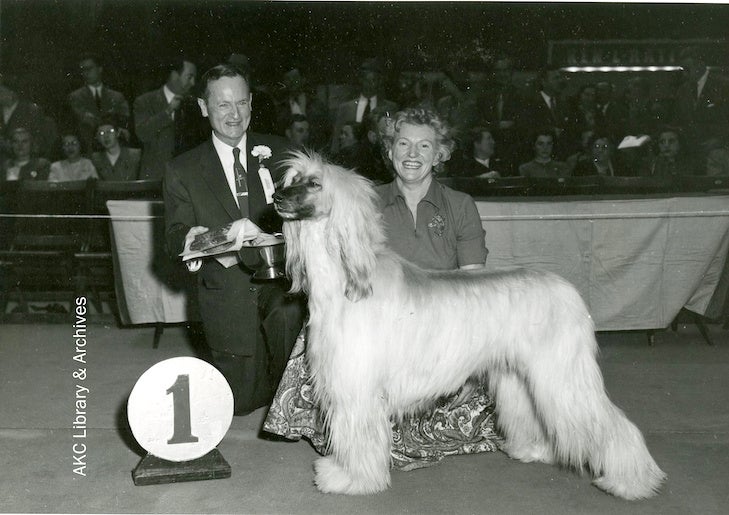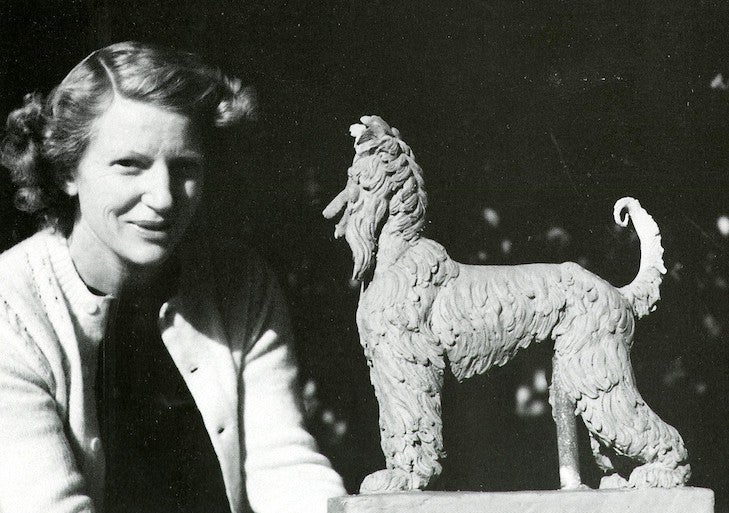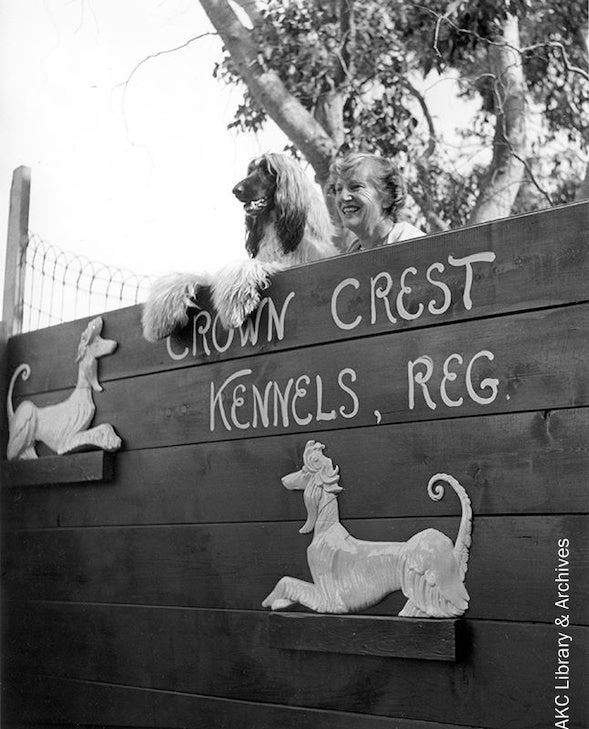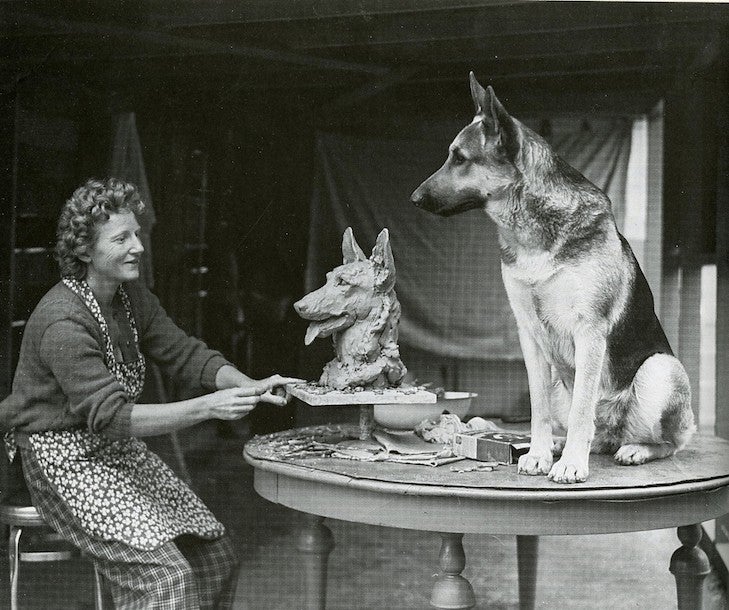
|
When it came time to celebrate their 25th wedding anniversary in 1947, Kay Finch’s husband Braden went with tradition and bought her something silver.
That gift was a silver-blue Afghan Hound named Felt’s Thief of Bagdad. Informally known as “Thumper,” he became one of the first big winners of his breed in the United States – and heralded the start of Crown Crest, the world-famous kennel of talented breeder and sculptor Kay Finch.
Master of Dogs — and Ceramics
Finch lived in Southern California, which in the last half of the 20th Century was booming with both dog shows and pottery manufacturers. She succeeded wildly at both: Dominating the show competition on the West Coast – much as her archrival, Sunny Shay of Grandeur, did in the east – Finch produced well over 100 Afghan Hound champions as well as some of the breed’s top-winning and most influential sires. At the same time, her Kay Finch Ceramics churned out hand-painted, pastel-hued figurines of everything from Chinese maidens to Persian cats.
Not surprisingly, Finch’s imaginatively modeled dogs are still avidly collected, especially her Afghan Hounds. But the living, breathing dogs that she produced left just as enduring a legacy.
Shown by the legendary handler and later judge Ellsworth Gamble, chinchilla-colored Thumper was Finch’s first champion, but not her first Afghan Hound. She first glimpsed the breed in 1929, wandering around an old California hotel. “I thought it was a longhaired goat or something,” she reminisced in an interview. “It looked like a million dollars … and I said, ‘If that’s a dog, I’m sure going to get one of those!'”
Finch had had two Afghan Hound before being given that fateful anniversary gift, one of them an unapologetic fence jumper who was killed on a highway. (Thumper himself barely survived his birth: He was born without any vital signs, and his mother refused to accept him for a full day.)

All Eyes on Johnnie
By the following decade, Finch – a striking figure in her bold-colored skirts and turquoise jewelry – was showing an even brighter star, Ch. Taejon of Crown Crest. A black-masked silver, “Johnnie” won the Hound Group at Westminster Kennel Club in 1954 and again in 1955, and was the first dog to grace the cover of Sports Illustrated. Finch valued dogs with confident and stable temperaments, and in that regard, the incomparably showy Johnnie – who was undefeated in breed competition for three consecutive years – did not disappoint.
“His personality won friends and influenced people,” Finch said in a 1974 interview, recalling a visit from some prominent judges who wanted to see Taejon. “I asked them to be seated in my living room and I would have ‘Johnnie’ come down,” she continued. “He could hardly wait to leap down two flights of stairs, then suddenly, he jumped high on the big grand piano where he took a stance and posed in his typical ‘John Barrymore’ manner and seemed to say, ‘Well, here I am, look me over?'”
One never knew what Taejon would do next, Finch admitted in half-admiration, half-despair. Indeed, he was the architect of her arguably most embarrassing moment, snatching the Best in Show ribbon out of the hands of iconic judge Alva Rosenberg.

Ophaal or Awful?
Around the same time her Johnnie was dominating American show rings, Finch was looking for a suitable outcross sire for her kennel. In 1954, she imported Ch. Ophaal of Crown Crest, a black-masked red, from Eta Pauptit of the famous van de Oranje Manege kennel in Holland.
“He is the type of Afghan you will like,” Pauptit wrote to Finch before sending her the 4-year-old, who was already a Dutch, Belgian and German champion. “He is big, he has a fine long head and good skull. Ring in the tail. Lovely nature, sweet, devoted and friendly with other dogs. He has that fine Eastern expression and springy gait which he gives to his offspring. Slant eyes and a gloriously rich, silken coat with a clear topknot. He adores people. Too sad that our souls must part but I am sure that he will be happy with you …”
Pauptit concentrated on a “mountain type” Afghan Hound, which had heavier bone and coat, as exemplified by the famous Afghani import Sirdar of Ghazni, who was only a few generations behind in Ophaal’s pedigree. Unlike anything that had been seen before in American show rings, Finch’s new import inspired some backbiting among her competitors, some of whom intentionally mispronounced his name as “awful.” In the end, however, Finch had her last laugh, as “Ope” sired more than two dozen conformation champions, and not a small number of racing ones as well.

Immortalizing the Afghan Hound
In her later years, Finch exclusively showed another of her most famous dogs, Am/Can. Ch. Crown Crest Mr. Universe, piloting the black-masked gold to 35 all-breed Bests in Show, a record at the time, as well as 100 Hound Group first and four national-specialty wins.
While Finch bred, showed, and judged other breeds – including Salukis and her original breed, Yorkshire Terriers – it’s for her Afghan Hounds that she is best remembered. And in her pottery, she found a way to immortalize them beyond the record books.
Sculpting more Afghan Hound figures than any other breed – twenty plus – Finch often modeled them after her own dogs. For example, the model that collectors call Standing Afghan #4830 took Thumper as its inspiration, while the 18-inch-tall Best in Show Afghan #5490 is none other than Taejon. And the glazed Afghan #5082 is a nod to her mentor, the aviatrix Marion Foster-Florsheim, and her famous Ch. Rudiki of Prides Hill, whose records Taejon eventually superseded.
So while the Crown Crest dogs no longer bound up and down the hillsides of Finch’s Corona del Mar home, they still populate china cabinets across the world, silent testaments to their breeder’s extraordinary artistry and timeless appeal.
“I think it’s a challenge to you because this creation that you are doing along with God is to be left as a pattern,” Finch mused to an interviewer about the process of producing flesh-and-blood dogs, though she could just as easily have been talking about her pottery ones. “And if you’re really dedicated, it’s got to be good.”

